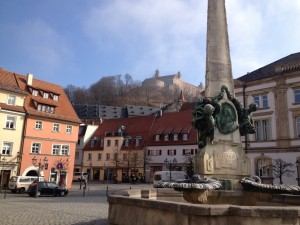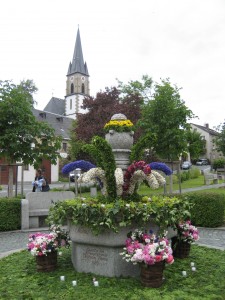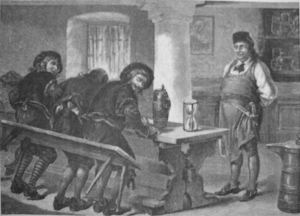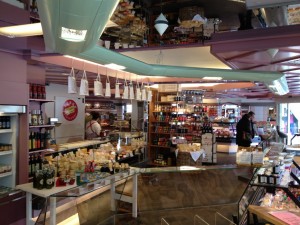Going back for a visit brings back the little quirks that are quite common in Germany but might not conform to our American ways. As pointed out in “Our featured Restaurant” article, some of the restaurants reviewed here are definitely in the upper echelon of the star rating system but many other are just posted for their, in our opinion, exceptional food together with their portion/price ratio.
We introduce many places frequented by the locals for their authentic food specialties, but with this you might encounter some ways which are strange to you.
- Many of the smaller restaurants, especially the country types do not take credit cards, though most of the one’s geared towards tourists accept plastic, but these are usually in good size towns or around “tourist magnets” and with this usually higher priced.
- A 15% tip is usually already included in the final check, but it is customary to “round up” the bill, so a 27.50 Euros bill would be rounded up to 30 Euros, if the service was good add up to 5%.
- Unless stated on a sign, refills for coffee and soft drinks including water are not free, not even at American chain restaurants like McDonald’s.
- Coffee in Restaurants or Cafés is expensive and is ordered by the cup or a little pot with about two cups in it called a “Kännchen”, again no refills.
- Water is not automatically served in restaurants but non-carbonated or carbonated Mineral Water is offered on the menu, again no refills. The city water is treated in most places, but it is up to you if you want to drink it! If yes, we had the good experience in some restaurants when we organized and escorted a group trip to Germany a few years ago, that we were not charged when asking for plain “Leitungswasser” (water from the pipe), but this was up to the individual restaurant manager.
- Some breakfast buffets at hotels include juices, coffee and also include refills.
- For buffet breakfast a tip is not mandatory, but 50 cents per person would be appreciated – put under your plate.
- If you happen to book a hotel “without breakfast included” don’t surprised if they charge you top dollars for it, it seems 10 – 15 Euros is common. Cheaper alternatives, besides the restaurants already open for breakfast would be the cafeteria in a shopping center or store, besides the “Kaufhof”, IKEA comes to mind or even some larger grocery stores.
- Entering a busy restaurant it can happen that you will be seated at a table with people you do not know or strangers might come up to your table and ask if it is OK to sit with you. A little different but through this we actually sometimes learned more about the area, exchanged experiences and made aware of interesting things to explore in the area.
- Stammtisch: Very common in Bavaria, it is a table with a sign on it and reserved for the regulars of the establishment, to sit there you have to be invited by a member or seated there by the host.
- In some restaurants if they bring a bread basket to the table and bread or hard rolls are not listed as part of your meal, they might charge you for the consumed bread, do not be surprised if that happens to you.
- You sat down, you ordered, the food is ready to serve, in many locations, again often the country restaurants will serve your food as it is ready, so one person might get their meal early as the noodles and the roast was already prepared, while the other person in your party is waiting for the Schnitzel to finish frying or the dumpling to be cooked fresh. So when your food arrives let everybody at the table watch you eat, as you will watch them once you are done. Don’t wait, as your food might get cold before the other meals arrive!
- There is no set rule that salads will be served ahead of your meal, especially a mixed plate of salads as it is very often the side of a Schnitzel dinner.
- Different rules apply in beer gardens, if it is posted you are allowed to bring your own food but you are required to buy the drinks from the host. We have also frequented beer gardens where you have to go inside, order your food and pick it up when it is ready.
- The German answer to fast food could be considered Imbiss-stuben or -stands. The stands are usually trailers from local butcher shops which serve a great Currywurst, Wieners on a hard roll with mustard or other quickly prepared foods which you usually eat standing up. On the main market place in Nuremberg a quick snack or side meal could be a hard roll with Bismarck herring and onions on it, try it you might like it!
- Buffets, use a fresh plate even if you don’t have to.
- Don’t be surprised if no vinyl gloves are worn by employees when preparing food.
- Ice cubes are not readily available in most restaurants and not served in drinks, although drinks are cold.
- We also encountered the presence of dogs in some restaurants.
- Restrooms are marked as W.C. (Frauen for women and Herren for men).
- Public toilets or those in restaurants. Most restrooms are well taken care off, after all this is Germany, but some of them are attended by a person supplying you with soap or towel, unless a price is posted the customary tip is 50 cents. Even in some restaurants there are pay toilets and you might need a coin to enter a stall. An example of this is McDonald’s in Hannover, the location in downtown has pay toilets to keep the non customers at bay while the one in a close by town does not.
While on the subject of differences from here to there, when shaking hands during a greeting, include the women too, as a matter of fact it is the rule that you shake a ladies hand before you shake the man’s and when exchanging handshakes in a group of 4 or more crossing over each others hands during the procedure is still considered “bad luck”.
And here I wish you a “Guten Appetit”
If any of you can think of other points that seemed odd to you during a visit please leave a comment.



























